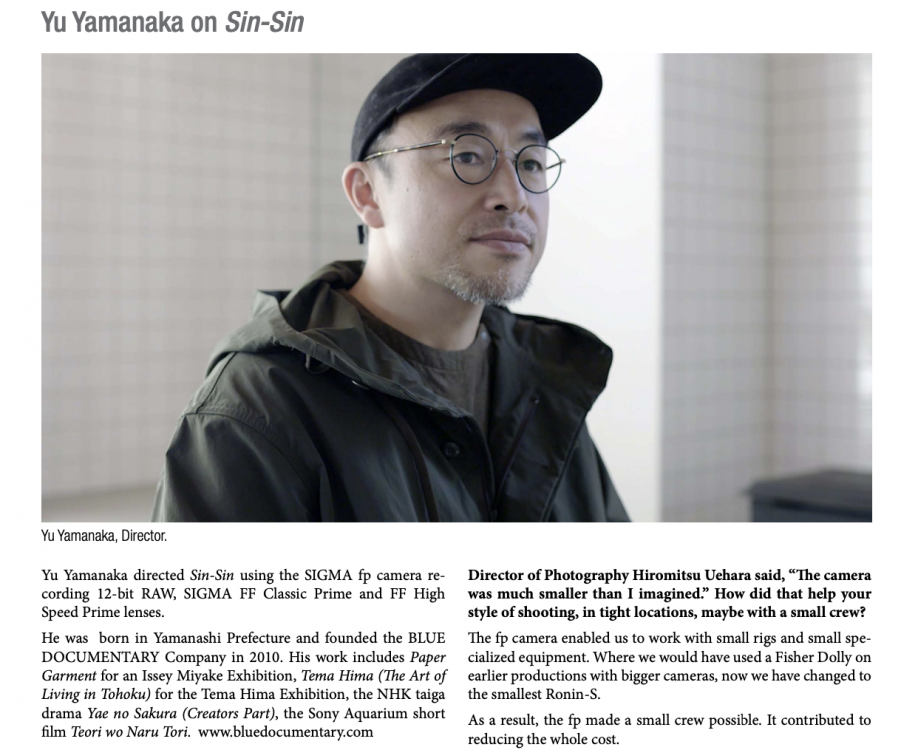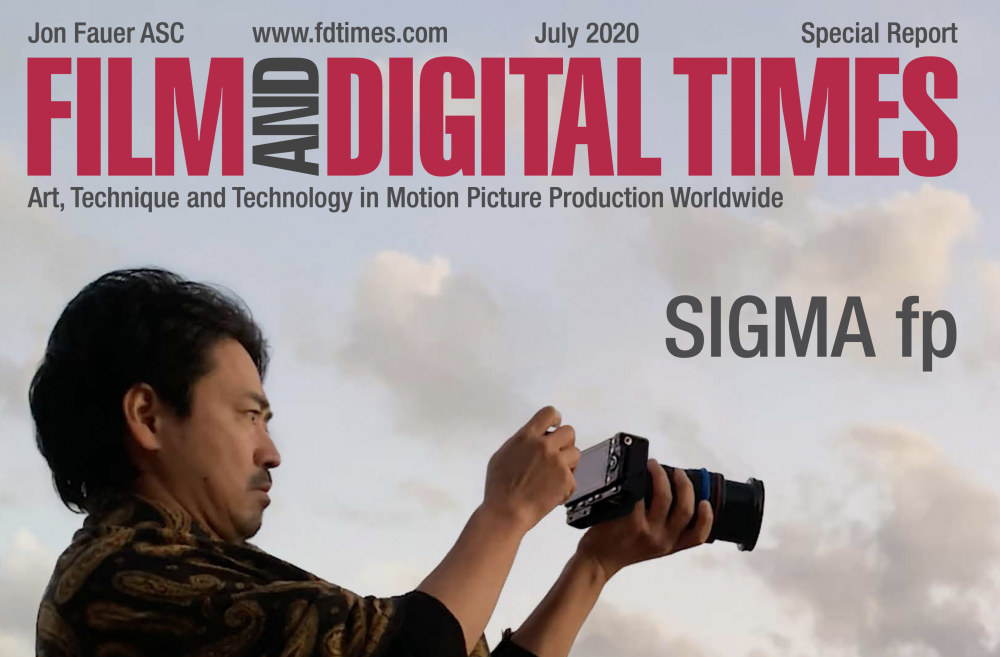-
Posts
15,479 -
Joined
-
Last visited
Content Type
Profiles
Forums
Articles
Everything posted by Andrew Reid
-
The forum has a new feature. It's an argue amongst yourself privately and save the EOSHD audience pages of off topic bullshit button. https://www.eoshd.com/comments/messenger/compose/
-
It seems to be some sort of flat profile now in the Off mode. Desaturated, brings the shadows up. Definitely seems to be more "Flat profile" than LOG but still interesting to further experiment with.
-
Some fair points in this
-
It was quite loose on mine and there's no positive locking adapter for EF that I know of at least.
-
Only the AF was better really. I did not warm much to it, and sent mine back to Amazon for a refund. Didn't even really feel the need to review it, because for the same money (actually less) you can buy a used E-M1 II which is very similar and better in many ways - ergonomically for instance, it also has LOG and latest AF speeds. So if you are going to move up from the E-M10 III, get a used E-M1 II or G9 for £650 that's my advice!
-

A new industry standard: Fully controlled reviewers
Andrew Reid replied to Andrew Reid's topic in Cameras
Here is an idea for all the camera companies. How about instead of flying everybody to Hawaii they start a fund for proper journalists and artists. From that fund, lots of great resources about cameras will spring and it will inspire others to take up the hobby or career of photos / videos. The shilling thing will eat itself eventually anyway and kill YouTube completely as a trustworthy website. -

A new industry standard: Fully controlled reviewers
Andrew Reid replied to Andrew Reid's topic in Cameras
Fuck me. Glad we are back on topic -

A new industry standard: Fully controlled reviewers
Andrew Reid replied to Andrew Reid's topic in Cameras
Maybe there aren't many left to point you to. But perhaps also if every thread you posted in didn't descend into rambling sycophantic difficult to understand nonsense about me, we'd find out. -
Isn't Sony just cannibalising their A6400 with the "vlogging" RX100 clone? Seems stupid. Panasonic are probably hurting sales of the GH5, G90 and more besides with the GX9-clone for vloggers.
-

A new industry standard: Fully controlled reviewers
Andrew Reid replied to Andrew Reid's topic in Cameras
I'd prefer you would not focus on me so much in the threads. I find it embarrassing to be honest. Talk to somebody else. -
The crop factor stills reduces the market for a stills camera, because full frame is the pro standard. It doesn't mean to say there is not a place for S16 and M43 in cinema, or even in stills. It does mean to say that customer choice is important and Olympus never stepped outside the one sensor size fits all bracket.
-

A new industry standard: Fully controlled reviewers
Andrew Reid replied to Andrew Reid's topic in Cameras
Again you are going on about the personal when the topic can and should be about the objective. Philip Bloom makes glossy reviews. That doesn't mean to say I am attacking him for it. However then @rawshooter pointed out that he was on a marketing directory of paid influencers. Which sort of reinforces the whole point of what I am saying about YouTube and marketing doesn't it. You are ok to think whatever. I don't think it is aggressive but it is subliminal shilling. The internet should not be a big shill platform in my view. They dominate in their role actually. At our expense. The Internet is user generated and interactive. It is actually up to us to make good content ourselves, and not just to surf for it. Are you suggesting I will sell out eventually? It is not just a business. Exactly You have only seen one post. I don't have to justify the 4th time I tell somebody to leave the community. 1 ban should be enough. If they rejoin again and again afterwards it doesn't matter what they post, they're almost always coming back with a vengeance towards the site owner and they're not welcome any more. Is this in any way difficult to understand? -

A new industry standard: Fully controlled reviewers
Andrew Reid replied to Andrew Reid's topic in Cameras
He was banned before twice and rejoined a third time to troll this topic. You think that's ok? -
Here in my opinion is how Olympus went wrong. A) Produced cameras which tended to do better in Asian markets. Did not focus on a more global picture. B) Ignored video users. It wasn't until 2016 that they even had a 4K mirrorless camera of interest to us, and then they did very little to capitalise on it. C) No progression to full frame Olympus system. It isn't that the Micro Four Thirds size sensor is to blame, even though most of the market is APS-C and Full Frame. Had Olympus stuck to DSLR bodies with a Four Thirds sensor and no mirrorless mount, we'd have probably had seen them leave the camera market 8 years ago! Olympus did very well with Micro Four Thirds but since the A7 III especially, full frame alternatives presented a very strong front particularly in the latter half of the decade due to falling prices. D) Mid-range Olympus lenses far too expensive E) In common with many other companies there's a complete failure to understand the connected devices and social media age, or online services and software apps. Let alone implement any of these aspects well. F) Lack of significant specs upgrade since E-M1 II. Reusing the same sensor in subsequent models and ageing LSI. G) Lack of total commitment and significant investment H) Lack of home-grown Olympus technology exclusives such as their own sensors or innovative parts, with exception of IBIS I) Marketing errors. Not being on the ball. Not reading the forums and relevant blogs.
-

A new industry standard: Fully controlled reviewers
Andrew Reid replied to Andrew Reid's topic in Cameras
The IR article you mean. Here we go. How about not making it about me in every topic? What's your opinion on the PR and sales industry? Good or bad? Does it help the camera industry or subvert the culture of the internet? -

A new industry standard: Fully controlled reviewers
Andrew Reid replied to Andrew Reid's topic in Cameras
What does that mean? -

A new industry standard: Fully controlled reviewers
Andrew Reid replied to Andrew Reid's topic in Cameras
Are you saying glossy camera reviews with a strong lifestyle element don't sell cameras? Philip Bloom is besides the point. You should learn to understand facts. -
It sounds like you'd be better looking at Nikon Z6 with Fringer EF adapter. It's practically an EOS R6 for autofocus and 4K recording... But dead cheap. Other than that, C200, C500 II, might be options? I did It's just that nobody watched or read it Most Canon users live in a state of constant denial.
-
That's another reason why it would be great to have a modern S35 2.5K or 2.8K sensor... 240fps without a crop or pixel binning... in BRAW. They really missed a trick going straight from 1080p to 4K. In fact the entire industry did! Not everybody needs 4K, even now. What we DO need is a cinematic image better than 1080p. When 8K comes with the EOS R5, it'll be interesting to see if people are still using it after 1 week.
-
Rather than go full frame as has been rumoured (let alone 8K), I think Blackmagic should bring back the old BMCC 2.5K sensor for a $999 model and do an updated Pocket 6K with same S35 sensor, but mirrorless L-mount or E-mount. Then they should go to work on the body and make a proper camera, not a potato, and sell for $2000. Minimum standard: Build quality to at least Panasonic GH5 or X-T4 level Large built in EVF like the competition Fully articulated screen, even if they have to make it smaller IBIS would be ideal Fix the battery life. it's completely unacceptable on the single Canon battery PDAF would be nice Then we have all the makings of a giant killer.
-
With the decline of retail stores, the tech industry has found a replacement for shop salespeople. YouTubers and reviewers. In fact these are far more effective with much greater reach and they don't even need to be paid actual hard cash. With the general public currently hypnotised by the lifestyle aspects of these channels (i.e. Philip Bloom style glossy videos), it's an easy sell. For this all to work so well, the public have to be in their current online addicted narcissist state. I really like Stewart Lee's take on this, it is the absolute truth and bloody funny. I was reading a few takes by the usual camera press on the Olympus situation recently. To determine how high the level of control is over the press, even a dying company continues to hold reviewers in a rapture. This Imaging Resource piece for instance, where they compare the transfer of Olympus imaging to vulture capitalists JIP to Sony buying Minolta!! Don't forget these are top editors with links to almost every PR person in the camera industry. https://www.imaging-resource.com/news/2020/06/25/can-olympus-thrive-after-the-sale-madavors-photo-editors-talk-it-through It isn't up to me to tell you whether it is outright lying or just complete denial / delusion! But it is one of the two. "Wes Pitts (Outdoor Photographer and Digital Photo editorial director): It could be a good thing in the long run. Olympus has struggled for a while now. Though it's not a totally analogous circumstance, this "carve-out" reminds me of the sale of Konica Minolta's image assets to Sony. That move eventually led to Sony completely disrupting the traditional DSLR market and emerging as the leader in mirrorless" William Brawley (Imaging Resource senior editor): Good thinking, Wes! I sure hope this new "Olympus Imaging company" does indeed follow a similar Konica Minolta-Sony path. It has also become clear that there is an orchestrated cartel of YouTubers, probably with agencies and managers pulling the strings. The occasional comment, the occasional share, it is not organic but completely pre-determined by a promotional strategy. A quid pro quo situation. 'You do this for me and I'll do this for you, and it boosts both channels' I think it is sickening the amount of shilling types out there and the way buyers are being manipulated.
-
In the latest issue of FDTimes there's a very interesting interview with the Japanese director behind the Sigma Fp short-ish film https://2stxv23ezngh2b8peu3esf6u-wpengine.netdna-ssl.com/wp-content/uploads/2020/06/103-FDTimes-300-SIGMA-fp2.00.pdf Worth a read
-
It would be great if Blackmagic put an BRAW FPGA in a small Ninja Star alike module, but have it powered via USB C rather than a brick of a battery. Actually scrub that. Put the chip in an USB C SSD, and have it convert the uncompressed 12bit RAW before it gets written to the drive. NvME size if possible.
-
I turn a blind eye to the AF as well. You should give it an AI eye add on Apparently according to Kazuto 30% of Fp sales were body only, indicating that manual focus lenses and adapters will be getting a lot of use on it! Autofocus, IBIS, built in EVF and tilt screen... Blackmagic Pocket 6K lacks them all! And so does the Fp. It’ll not be the A7 III replacement for the specs sheep. But just look at the images. 12bit BRAW 4K vs 8bit Sony XAVC! I may get the viewfinder loupe for it. And gorilla pod for handheld work. You can argue it would look less weird than IBIS if used nicely this way.
-

Sigma Fp review and interview / Cinema DNG RAW
Andrew Reid replied to Andrew Reid's topic in Cameras
In my opinion the camera industry could learn a lot from the open source community. Having so many exclusive patents and licenses really hurts the entire industry. Every single company would benefit from an open source compressed RAW codec. I think it is also what keeps us from better integration of the external solutions as well. We are never going to progress from a HDMI cables, because as soon as an external recorder connects more directly with a camera body, it probably counts as internal recording and thus violates the RED patent. It stops more modular designs. I would love to know what ideas and products RED's patent has killed off and whether this actually makes RED money in the long term. I don't think it does. Fair play to Mr Nattress. His work deserves long-term, rich reward. But come on. It's time to push forward together as one industry.







